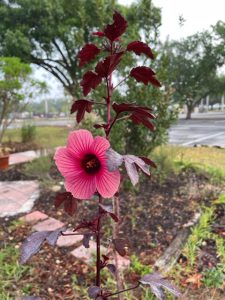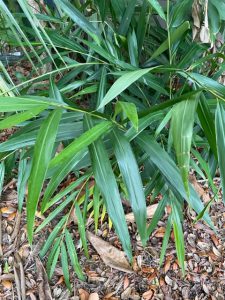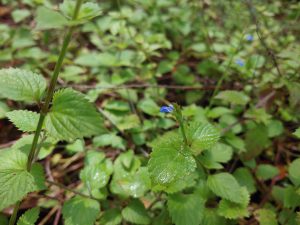Do you remember fistfuls of strawberries, the honeyed glace smell, dripping red juice over knuckles, sticky with the sweet sourness in the warm summer sun? Or maybe, the rich smell of fresh, cascading soil falling from carrots pulled from their hidden homes below the rich earth? The scent emanating when brushing past rosemary in your grandmother’s front walk? We often think of landscapes as a backdrop, an etched pallet, static dressing up the edges of our built spaces without the added purpose of producing sustenance. The vegetable or edible garden has in many cases been separated from our aesthetic landscape to a 4 ft. by 8 ft. rectangle in the backyard, where we can briefly grow a handful of tomatoes. What if we could amble idly through sunny walkways and dappled shade to feed ourselves? The garden no longer needs to be encumbered by the limitations of raised beds or rows of seasonal vegetables. Edibles can fill our landscape beds and spill out, with smell, color and flavor amongst the traditional textures, inflorescence, and structure of branch, leaf and vine that define the aesthetic of our traditional ornamental planting beds.
There are numerous edibles that can be incorporated into the garden; however, this article is going to focus on some lesser-known edible plants that are easy to propagate or purchase, can be utilized in most climatic zones in Florida and have a good variance of light tolerance. These plants can be discovered and shared with visitors to your garden. Depending on how they are utilized they can blend into the backdrop or emanate as focal points and conversation pieces that engage a broader reach of the senses.
The edible landscape plants in this article are, Cranberry Hibiscus, Ginger, Creeping River sage, and Everbearing mulberry. These plants are vastly different in form and function within the garden which helps illustrate the many ways edible plants can be utilized in the traditional landscape. This article is the first in a series which will discuss a variety of recommended plant species to incorporate edibles throughout your landscape. Each article will highlight species that are adapted to a range of light and soil conditions of varying forms such as shrubs, vines, trees, edible rhizome or groundcover.
 Cranberry Hibiscus (Hibiscus acetosella) -Perennial or annual Shrub
Cranberry Hibiscus (Hibiscus acetosella) -Perennial or annual Shrub
The deep purple foliage of this multi-stem leggy shrub warms the negative spaces of the garden. The serrated shape of the leaves is reminiscent of the Japanese maple. Cranberry Hibiscus grows up to a height of 3-6 feet and is a perennial in zones 8 and 9 but can also be grown as an annual in colder climates or in containers inside or outside. The bright red flowers produce rough seed pods that can be left in the garden to wait in dormancy for the next year collected and stored in the fridge through the winter and sewn in the spring. Cranberry Hibiscus is tolerant of full sun or dappled shade and well drained soils.
The edible parts of the plant are the leaves and flowers. The sour, unique tasting leaves can be ingested raw, mixed in with salads or added to a sandwich or wrap. The fresh or dried young flowers can be used to brew refreshing tea on their own or can be mixed with ginger, tamarind, and other spices for different flavor profiles. It can also be made into a simple syrup and added to your favorite cocktail. Cranberry hibiscus leaves and flowers contain antioxidants, calcium, iron, and vitamins B2, B3, and C.

Ginger (Zingiber officinale)- Perennial Rhizome
This tropical plant grows in zones 8-12 and sends up flowing shoots from the rhizomes. The edible varieties of ginger are spindlier and usually have more subtle inflorescence than familiar ornamental varieties. However, the scent of the flowers is sweet and mysterious, and the slender structure makes them easier to manage. Edible gingers grow to a height of 3 feet or less and can be separated and replanted annually during harvest. With time and patience, a single ginger rhizome can help populate many areas of the garden.
The real treat in this plant comes 8-10 months after planting. Harvesting fresh tender ginger rhizomes is one of the most satisfying garden activities imaginable. Digging into the soil with a hoe or garden fork and carefully pulling the rhizomes apart releases the sweet familiar smell of the ginger into the air and scrubbing the soil off the harvest is exciting as preparing the ginger. Ginger rhizome has many uses and applications and can be added to dishes as a spice, juiced and added to smoothies or consumed as a spicy supplement, or brewed as a tea or ginger bug for beer.
Ginger also has powerful medicinal properties. The natural flavor and fragrance of ginger comes from its natural oils. One of these is gingerol a powerful bioactive compound in ginger that has anti-inflammatory and antioxidant effects according to research. Science has also supported the traditional use of ginger to reduce nausea and research has been done that indicates that ginger may help with weight loss, osteoarthritis, cancer reduction, digestion, and brain function. The many edible types of ginger that can be used in the garden have subtly different heat and flavor.

Everbearing Mulberry (Morus rubra)- Small Tree
The Red Mulberry is a wispy native tree that exists throughout the United States and can survive from zones 4-10. The everbearing variety can live up to 125 years and grow up to 20 feet tall and 20 feet wide. Everbearing Mulberries are deciduous, small trees with ovate leaves with serrate edges can form a structural component to any garden. They prefer full to part sun and can handle moisture so are ideal for slightly wet areas of the garden.
The frequent flushes of small 1-inch fruits are produced in cycles throughout the year. Ripe fruits resemble blackberries but have a much sweeter flavor and can be consumed fresh or dried, and made into jams, jellies, or wine. Mulberries are full of many compounds that have health benefits. They are a reliable source of fiber and contain antioxidants, vitamin C, Iron, Potassium, Vitamin K1 and Vitamin E.
These little amethysts of the garden are frequently consumed by birds and small children alike. It is always good to have a clear path to the tree with understory planting that can handle the odd trample because once discovered they are magnets and are the beginning and end of many a garden amble. The flexible limbs bow with the weight of those reaching for the promise of one more fruit. Not to worry if the branches break though, the mulberry is easily propagated with woody cuttings and a broken limb just presents a new opportunity to add more mulberry trees to the garden or share plants with friends and family.

Creeping River sage (Salvia misella)- Ground cover
This native plant grows in zones 9a-11, found ubiquitously throughout Florida and into the Caribbean. As the name suggests it creeps surreptitiously across the ground surface, weaving an aromatic groundcover. Found in dappled shade to part sun this plant provides an excellent choice for those areas where grass may be difficult to grow due to low light. It tolerates a range of soil types but prefers not to be left parched and can handle slightly boggy or low-lying areas that may be problematic for other species. Spring provides a profuse delight of periwinkle blooms while the evergreen foliage presents a delicate gray-green softness through the rest of the year. Once planted, Creeping River sage will resprout via seed and occasionally stoloniferous rooting. You will find it meandering its way around plants of taller foliage or filling in the space underneath trees.
This plant can provide a lovely aroma when brushed in passing or underfoot. The leaves have a savory mint-like flavor which when picked freshly make a great addition to salads. Flowers are also edible and can be a welcome sight atop savory baked goods or quiches. An added benefit of this uncommon edible is that it is the host plant for the native fulvous hairstreak butterfly, a delightful, small presence in any landscape.
 10
10
